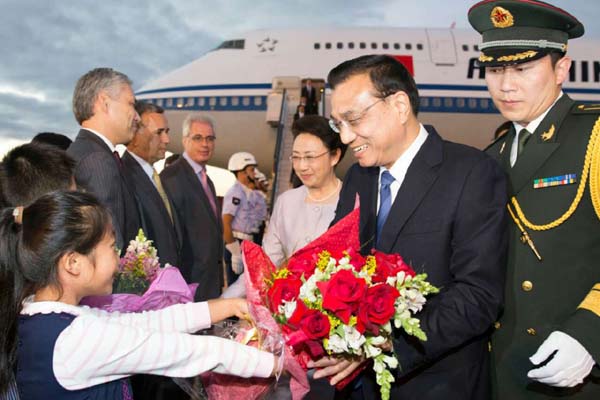Chinese Premier Li Keqiang's ongoing visit to Latin America consolidates a new era of cooperation between China and the region. This comes about as China has been rethinking its engagement with Latin America in order to broaden the relationship beyond trade links. Therefore, Li's visits to Brazil, Colombia, Peru and Chile mark a turning point in regional relations as a whole. The agreements and discussions to be held will point to the development of the cooperation infrastructure between China and Latin America.
So far, trade dynamics have set the tone and patterns of the overall relationship. As a result, although trade increased at an annual rate of 27 percent from 2000 to 2013, primary products have been dominating the region's export basket to China. Similarly, the period has seen the predominance of a few products in the trade between Latin America and China. For example, and as figures from the UN Economic Commission of Latin America and the Caribbean show, while in 2000 five main products accounted for 47 percent of the value of regional exports to China, in 2013 the same five products accounted for 75 percent of the total.
 |
|
Premier Li Keqiang arrives in Brasilia, the capital of Brazil on the afternoon of May 18 local time to kick off his official visit to Latin America. Brazil is the first leg of the Premier's Latin American tour that will also take him to Colombia, Peru and Chile. During the Premier's three-day visit to Brazil, China and Brazil, as members of the BRICS bloc of emerging economies, will discuss cooperation focusing on production capacity and equipment manufacturing. [Photo/Xinhua] |
Yet, and as new economic conditions shape the ongoing reform in China, new synergies can be created with Latin America to support the restructuring of the Chinese economy away from exports and toward a higher domestic investment in a more innovation-driven growth led by public consumption. In this regard, overcapacity dilemmas plus excess capital in China could find their way to Latin America to cushion the challenges at home with sustained growth abroad.
This also would be beneficial for Latin America, because through adequate transfer of technologies and skills the region could start addressing its long-standing industrialization question according to the factor endowments its economies posses. With this feedback, Chinese enterprises operating in more market-driven economies in Latin America could, additionally, strengthen their abilities in following market decisions for allocating risks and resources. Naturally, they could replicate these lessons back in China.
The interactions that emerge will boost mutual understanding both sides require to be able to bridge their differences and achieve substantial results. With that target, both sides could also reinforce efforts especially in three fields: state transformation, industrial cooperation and infrastructure. As for the first one, since China and Latin America are part of the developing world, they could begin exchanging more experiences on the policies they have for strengthening state capacity to address common development challenges. For example, they could promote greater understanding of the policies they are adopting to ensure efficiency in the decentralization processes, including greater budget responsibility for local governments.
In industrial cooperation, China and Latin America should create more room for working teams to work out processes that organize and coordinate actions for seeking initiatives, which, in turn, integrate their value chains. In this context, it is important to prioritize sectors in which comparative advantages could be turned into competitive ones - for example, agriculture, which has huge potential for meeting the complementarities of the two sides.
Moreover, infrastructure has a huge pool of cooperation resources. Latin American countries, like many of their Asian counterparts, have a big infrastructure deficit that cannot be filled with intra-regional help alone. China, given its experience and resources, could step into this sector to improve the regional economic infrastructure. China could do so best with regional and local players and through public and private partnerships, for they will make its access to the region easier and give it the knowledge to mitigate risks.
In short, if China and Latin America can build a sound cooperation infrastructure, they would foster their capacity development while enhancing their capacities to interact with each other to jointly pursue economic growth and sustainable development. If they meet the new challenge, they would not only make new contributions to South-South cooperation but also acquire more strength to play a greater and more constructive role in the globalized world.
The author is principal executive of CAF Development Bank of Latin America in China.

I’ve lived in China for quite a considerable time including my graduate school years, travelled and worked in a few cities and still choose my destination taking into consideration the density of smog or PM2.5 particulate matter in the region.